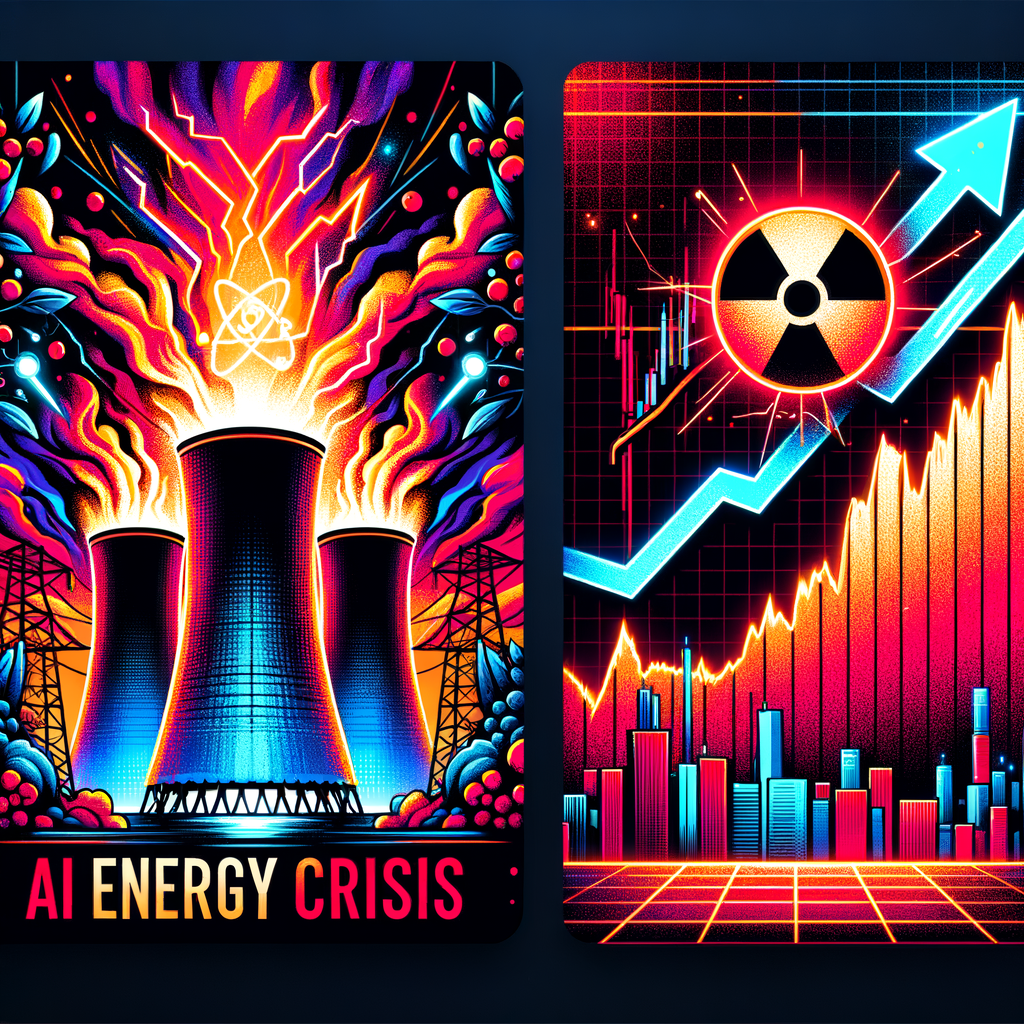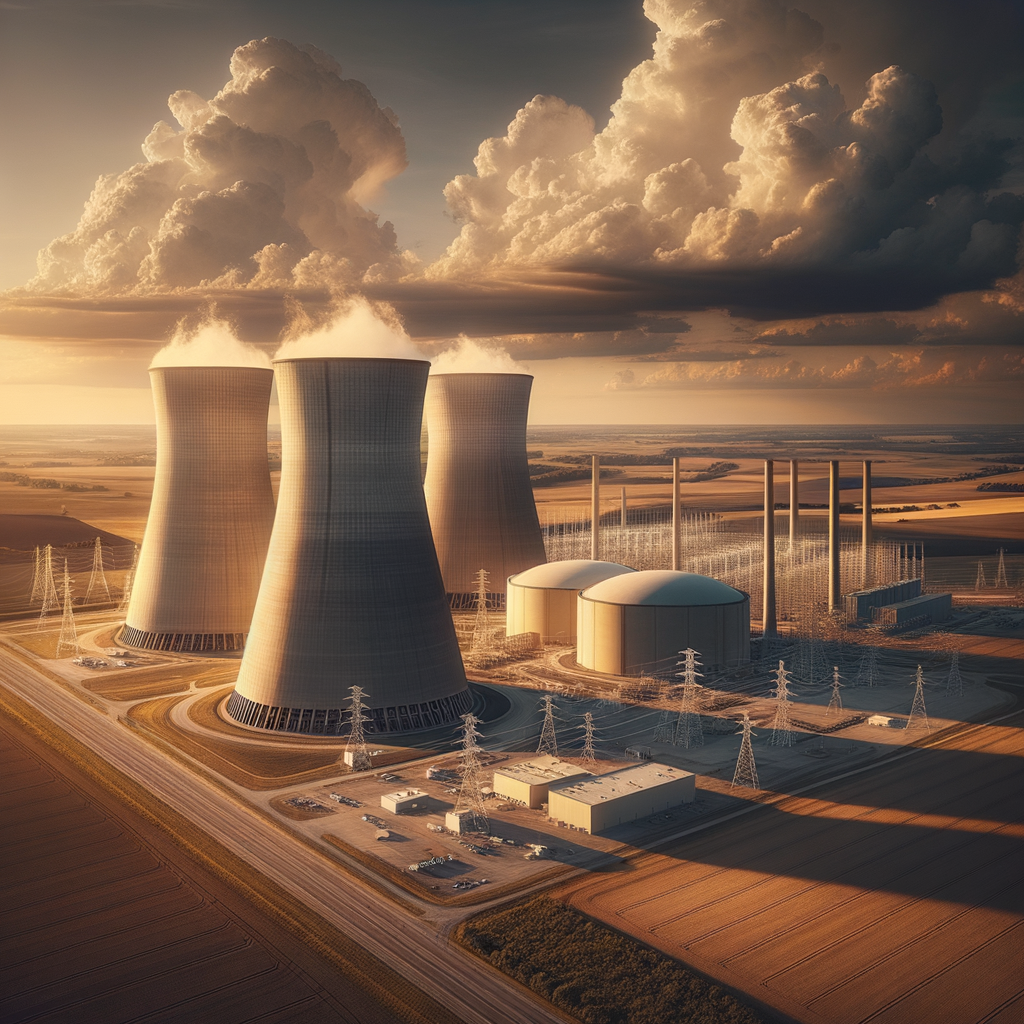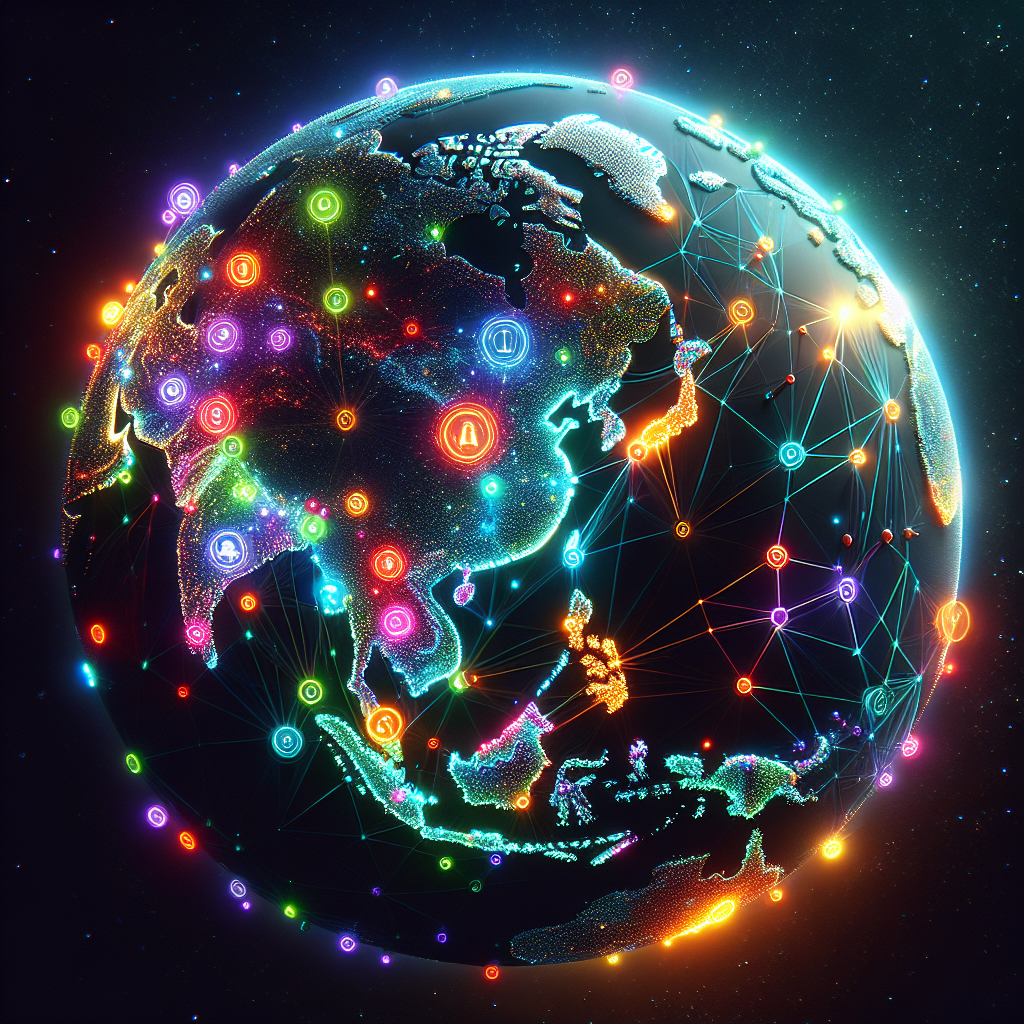Google Revives Nuclear Plant for AI, OpenAI Demands 100 Gigawatts & Cathie Wood's Market Reality Check – Daily AI News, Oct 28, 2025

AI's relentless growth is colliding with the harsh reality of its massive energy consumption, creating an energy crisis that demands immediate attention. To stay ahead of countries like China, businesses must prioritize innovative and sustainable energy solutions to power their AI ambitions, or risk falling behind in this critical technological race. Stay informed on these infrastructure shifts by following key sources of AI News.
AI's Thirst for Power: A Growing Crisis
AI's voracious appetite for data is translating into an equally insatiable thirst for power, a reality that's rapidly escalating into a full-blown crisis. The exponential energy demands of training and running increasingly complex AI models are forcing tech giants like Google and OpenAI to not just innovate in algorithms, but also to become unexpected players in energy infrastructure. This shift is driven by the staggering projections of future energy consumption within the AI sector.
The Data Center Dilemma: An Energy Black Hole

The heart of the problem lies within the massive data centers that house and power AI systems. These facilities, already significant energy consumers, are facing unprecedented demand. Experts predict that data center energy consumption will more than double by 2030, soaring to a staggering 415 terawatt hours. To put that into perspective, that's more than the entire annual energy consumption of some countries! This surge is fueled by the computational intensity of Large Language Models (LLMs) and the increasing deployment of AI across various industries. Companies are scrambling to find sustainable solutions, exploring options like on-site renewable energy generation and advanced cooling technologies, but the scale of the challenge is immense.
The US 'Electricity Gap': A Threat to AI Dominance
Beyond the immediate logistical challenges, the escalating energy demands of AI pose a strategic threat. The United States, a leader in AI innovation, is facing a growing 'electricity gap' compared to countries like China. This gap threatens to undermine the nation's ability to maintain its competitive edge in AI development and deployment. Without sufficient and reliable energy resources, US-based AI companies may struggle to scale their operations, potentially ceding leadership to nations with more robust energy infrastructure. This is not just an economic concern but also a matter of national security, as AI becomes increasingly integrated into critical infrastructure and defense systems. The AI News is rife with discussion of strategies to close this gap, but implementation remains a significant hurdle.
The race to power the future of AI is not just about technological prowess; it's about securing the energy resources necessary to fuel that technology. As AI continues to evolve and its applications expand, the energy crisis will only intensify, demanding innovative solutions and strategic investments in sustainable energy infrastructure. The stakes are high: the nation that can effectively address this challenge will likely emerge as the dominant force in the age of artificial intelligence.
Google Revives Nuclear Plant to Fuel AI Expansion
Just when you thought nuclear energy was fading into the history books, Google is giving it a jolt of new life, all in the name of powering its ever-expanding AI empire. The tech giant has partnered with NextEra Energy to breathe new life into Iowa's Duane Arnold Energy Center, a nuclear power plant that had previously been shuttered. This isn't just about keeping the lights on; it's a strategic move to fuel the voracious energy appetite of Google's cloud and AI operations. It's all part of an effort to reduce the AI carbon footprint. Let's dive into what this means for the future of AI and energy.
A Nuclear Renaissance Powered by AI
The Duane Arnold Energy Center, boasting a substantial 615-megawatt capacity, is poised to deliver around-the-clock, carbon-free electricity directly to Google's data centers. This initiative underscores the escalating energy demands of AI technologies. Training complex models like Google Gemini requires immense computational power, and that power needs to come from somewhere. This decision to revive a nuclear plant signals a potential turning point: AI’s growth may well spark a renaissance for the nuclear industry, as other tech companies seek reliable and sustainable energy sources to power their AI ambitions. It also underscores how important it is to promote sustainable AI.
Addressing AI's Growing Energy Needs
AI's energy consumption is no joke. As models become more sophisticated and data sets grow larger, the amount of electricity needed to train and run them skyrockets. This partnership between Google and NextEra Energy highlights a growing awareness of the environmental impact of AI and a commitment to finding greener solutions. By tapping into nuclear power, Google is aiming to minimize its carbon footprint and demonstrate that AI innovation can coexist with environmental responsibility. Google is showing that green energy for AI is not just a buzzword, it is something they are investing in.

A Glimpse into the Future
Google's move could set a precedent for other major players in the AI space. As the demand for AI continues to surge, expect more companies to explore innovative energy solutions, including nuclear, to power their operations. This trend could reshape the energy landscape and accelerate the transition to a cleaner, more sustainable future, driven by the very technology that once seemed destined to exacerbate environmental problems. This is definitely a space to watch in the coming years, especially in our AI News section.
OpenAI's Plea: 100 Gigawatts Annually to Beat China
The AI race isn't just about algorithms and data anymore; it's rapidly becoming an all-out infrastructure war, and OpenAI is sounding the alarm. The company has reportedly urged the White House to prioritize adding a staggering 100 gigawatts of power capacity annually to keep pace with China's rapidly expanding AI capabilities. This plea underscores a fundamental shift: electricity has become the linchpin of AI dominance.
Electricity: The New Oil
Sam Altman, CEO of OpenAI, has famously declared that "electricity is the new oil." This isn't mere hyperbole; it's a stark recognition of the energy-intensive nature of modern AI. Training large language models (LLMs) like ChatGPT, a revolutionary chatbot capable of engaging in human-like conversations, requires massive amounts of computational power. As AI models grow ever larger and more complex, their energy demands skyrocket, making access to reliable and abundant electricity a critical strategic advantage. Think of it like this: the best AI algorithms are like the most powerful engines, but without enough fuel (electricity), they're just expensive paperweights.
The US vs. China: An Energy Capacity Gap

OpenAI's concerns are rooted in the fact that China is outpacing the US in expanding its power generation capacity. Last year alone, China added significantly more power capacity than the US, signaling a growing disparity in the infrastructural foundation needed to support AI development. This imbalance raises the specter of China gaining a decisive lead in AI innovation simply by having more readily available power to train and deploy advanced models. The implications are far-reaching, potentially impacting everything from economic competitiveness to national security. To keep pace, the US must aggressively invest in expanding its energy infrastructure, ensuring that its AI companies have the resources they need to compete on a global stage. You could also look to optimize your models using tools like Hugging Face Transformers, an open-source library providing pre-trained models and tools for NLP tasks, that can help reduce overall computational costs.
The Infrastructure War
The AI competition has thus evolved beyond mere technological innovation. It's now a contest of infrastructure, where electricity capacity effectively determines technological leadership. The nation that can secure and supply the most power will likely be the one that dominates the AI landscape. This means not only building new power plants but also investing in smarter grids, renewable energy sources, and energy-efficient AI hardware. The race is on to not only create the best AI but also to power it sustainably and reliably, and the stakes have never been higher. Staying on top of the latest developments with AI News will be crucial to understanding how this infrastructural competition unfolds.
AI Market Reality Check: Valuation Concerns and Interest Rates
The AI revolution is undeniably exciting, but some experts are urging caution, pointing to potential cracks in the foundation of its soaring market valuations. Cathie Wood, CEO of Ark Invest, has voiced concerns about an impending 'reality check' for the AI market, not necessarily signaling a bubble, but suggesting a necessary recalibration as interest rates continue their upward trajectory. While the long-term potential of AI remains immense, the current market exuberance might be outpacing the near-term realities of profitability and widespread adoption.
The Interest Rate Factor
The core of Wood's argument rests on the inverse relationship between interest rates and asset valuations. Higher interest rates make borrowing more expensive, reducing the present value of future earnings. This dynamic particularly impacts high-growth sectors like AI, where companies are often valued based on projections of significant profits far into the future. As interest rates rise, these future earnings become less attractive in today's dollars, potentially leading to a correction in AI valuations.
Disconnect Between Price and Profitability
One of the major concerns highlighted by analysts is the disconnect between the lofty valuations of some AI companies and the uncertain timelines for achieving substantial profitability. Many AI ventures are still in the early stages of development, requiring significant upfront investment in research, infrastructure, and talent. While the promise of transformative AI applications is compelling, the path to widespread commercial success is not guaranteed, and the timeline for realizing those returns remains unclear. This uncertainty creates a significant AI investment risk and may justify a more conservative approach to valuation.

Navigating the Correction
While a market correction can be unsettling, it's often a necessary and healthy part of the investment cycle. For investors in the AI space, this potential AI market correction presents an opportunity to reassess their portfolios, focus on companies with strong fundamentals and realistic business models, and potentially acquire positions in promising ventures at more reasonable prices. Diversification and a long-term perspective are crucial for navigating the inherent volatility of emerging technologies. As the AI landscape continues to evolve, a grounded and pragmatic approach to investment will be essential for capturing its long-term value. Consider tools like Google AI Studio, which helps developers build and experiment with AI models, as a harbinger for broader adoption and value creation in the field.
AI and Inequality: A Growing Global Concern
The glittering Future Investment Initiative conference in Saudi Arabia, a showcase of technological ambition, also cast a shadow: growing fears that AI advancements are poised to widen, not close, the chasm of global inequality. While AI promises unprecedented progress, the specter of its benefits accruing disproportionately to a select few looms large, raising critical questions about fairness and access in the age of intelligent machines. This concern isn't just theoretical; it's a tangible worry echoed by policymakers and thought leaders worldwide. Tools like ChatGPT, a powerful language model capable of generating human-quality text, while democratizing access to information, could also exacerbate existing advantages if only a privileged segment of the population can fully leverage its capabilities. Concerns like these place the topic of AI ethics front and center for global regulators.
The Exacerbation of Existing Disparities
AI, for all its potential, runs the risk of amplifying existing societal fault lines. Consider the impact on the job market. Automation driven by AI could displace workers in routine tasks, further marginalizing those already struggling with economic insecurity. Conversely, highly skilled individuals who can harness AI tools to enhance their productivity will likely see their earning potential soar. This creates a feedback loop where the rich get richer and the poor get poorer, intensifying the feeling of powerlessness for those left behind. Moreover, access to AI tools and resources is far from uniform. Wealthier nations and organizations have a distinct advantage in developing, deploying, and benefiting from AI technologies, potentially leaving developing countries further behind. Even something as simple as access to reliable internet can be a barrier.
Grappling with Distribution: The Call for Policy Intervention
Across the globe, nations are beginning to grapple with the thorny issue of AI's distributional effects. The understanding is growing that a laissez-faire approach is unlikely to yield equitable outcomes. Without proactive policy interventions, the benefits of AI are likely to concentrate among the elites, widening the gap between the haves and have-nots. This necessitates a careful consideration of how to ensure that AI serves the broader public good. Potential solutions include investments in education and training to equip workers with the skills needed to thrive in an AI-driven economy. Additionally, governments may need to explore innovative mechanisms for redistributing the wealth generated by AI, such as universal basic income or enhanced social safety nets. Exploring resources like the AI Glossary can provide a foundational understanding for navigating these complex discussions.
The challenge lies in harnessing AI's transformative power while mitigating its potential to exacerbate inequality. It requires a concerted effort from governments, businesses, and researchers to ensure that AI becomes a force for inclusive growth and shared prosperity.
Ultimately, addressing AI inequality requires a multi-faceted approach, blending technological innovation with thoughtful social and economic policies. It's a challenge that demands our immediate attention, as the choices we make today will shape the future of opportunity for generations to come.
Ricoh's AI Pivot: Automating Enterprise Processes
While the spotlight often shines on AI's consumer-facing marvels, the underappreciated revolution lies in its capacity to overhaul enterprise operations; a shift exemplified by Ricoh's strategic pivot.

Ricoh's Turn Towards AI Automation
Ricoh, a name synonymous with printers and office equipment, has officially launched RICOH Intelligent Automation, a global AI-powered platform designed for enterprise process management. This platform aims to streamline workflows, automate repetitive tasks, and improve overall efficiency. This move signals a monumental transformation for the company, transitioning from its historical focus on hardware manufacturing to the burgeoning field of AI services. It's like a car manufacturer deciding to focus on self-driving software – a fundamental change in core business.
The Broader Impact of Enterprise AI
Ricoh's initiative underscores a crucial, often overlooked, aspect of AI's commercial impact: its transformative potential in back-office automation. While tools like ChatGPT, a versatile AI chatbot, are grabbing headlines, AI's impact on enterprise workflows could be even more profound. By automating tasks such as data entry, document processing, and invoice management, AI promises to boost productivity and reduce operational costs significantly. Consider intelligent document processing, which can automatically extract and classify information from various document types, saving countless hours of manual labor.
Reshaping White-Collar Work
The implications of this shift are far-reaching, potentially reshaping the very nature of white-collar work. As AI takes over routine tasks, employees can focus on higher-value activities that require creativity, critical thinking, and complex problem-solving. This transition necessitates a proactive approach to reskilling and upskilling the workforce, ensuring that employees are equipped to thrive in an AI-driven environment. Companies may need to invest in training programs that focus on areas such as data analysis, AI ethics, and human-machine collaboration. Ultimately, the successful integration of AI into enterprise processes will depend on how effectively organizations can adapt their workforce and workflows to leverage the technology's full potential.
Ricoh's move represents a significant bellwether, highlighting the growing importance of AI in transforming enterprise operations and hinting at a future where AI-powered automation is no longer a luxury, but a necessity for staying competitive.
Analysis: The AI Energy Crisis Meets Market Reality
The relentless march of AI is starting to bump up against a hard, unyielding wall: the laws of physics, specifically, the sheer amount of energy required to train and run these models. The AI energy crisis is no longer a distant threat; it's colliding with market realities in ways that are forcing a reassessment of the entire AI landscape.
Pricing in the Power Drain
For a long time, the narrative around AI has been dominated by breathless enthusiasm and sky-high valuations. However, markets are beginning to sober up, and are starting to price in the enormous infrastructure costs needed to fuel the AI boom. Think about it: every query to ChatGPT, the groundbreaking language model, requires significant computational power, and that power comes with a hefty energy bill. Investors are now scrutinizing the disconnect between these massive operational expenses and the projected revenue timelines for many AI ventures. The question isn't just, "Can AI do amazing things?" but "Can AI do amazing things profitably?"
Beyond Consumers: AI's Expanding Footprint
The initial wave of AI adoption focused on consumer-facing applications – chatbots, image generators, and the like. However, the next phase promises to be even more energy-intensive. We're seeing a push towards enterprise automation, where AI is used to optimize complex industrial processes, manage supply chains, and even design new products. Furthermore, AI is increasingly being deployed in geopolitical strategy, for tasks like intelligence gathering, cybersecurity, and even autonomous weapons systems. This expansion into energy-hungry sectors will only exacerbate the AI energy crisis. For example, imagine using a tool like Sora, OpenAI's text-to-video model, to generate high-fidelity simulations for military training; the energy footprint would be staggering.
Questioning the Investment Thesis
Ultimately, the AI industry is facing some tough questions. Is the current investment thesis sustainable, given the energy demands of these technologies? Are the deployment timelines realistic, considering the infrastructure limitations? These are not merely technical challenges; they are fundamental economic considerations that will shape the future of AI. As these considerations become more prominent, expect to see increased focus on energy efficiency, novel computing architectures, and perhaps even a slowdown in the breakneck pace of AI development. Navigating this AI energy crisis will require a blend of technological innovation, strategic foresight, and a healthy dose of market realism.
🎧 Listen to the Podcast
Hear us discuss this topic in more detail on our latest podcast episode: https://open.spotify.com/episode/3n5k1GAa3St33i3HEGCvZo?si=fx9qB96WSZGYDKwrDFIJUw
Keywords: AI, Artificial Intelligence, Energy Consumption, Data Centers, Renewable Energy, Nuclear Power, Google, OpenAI, Cathie Wood, AI Investment, AI Market, AI Automation, AI Infrastructure, AI Ethics, AI Inequality
Hashtags: #AI #ArtificialIntelligence #EnergyCrisis #TechNews #FutureofAI
For more AI insights and tool reviews, visit our website https://best-ai-tools.org, and follow us on our social media channels!
Website: https://best-ai-tools.org
X (Twitter): https://x.com/bitautor36935
Instagram: https://www.instagram.com/bestaitoolsorg
Telegram: https://t.me/BestAIToolsCommunity
Medium: https://medium.com/@bitautor.de
Spotify: https://creators.spotify.com/pod/profile/bestaitools
Facebook: https://www.facebook.com/profile.php?id=61577063078524
YouTube: https://www.youtube.com/@BitAutor
Recommended AI tools
Google Cloud Vertex AI
Data Analytics
Unified AI and cloud for every enterprise: models, agents, infrastructure, and scale.
Apify
Data Analytics
Automate Anything
OpenRouter
Conversational AI
The Grid Operator AI Needs
Weights & Biases
Data Analytics
The AI Developer Platform
Contentful
Writing & Translation
Content infrastructure for digital teams
EOS Data Analytics (EOSDA)
Data Analytics
Bringing Space Data Down to Earth


